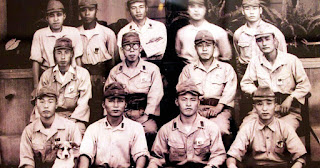The old PHOTO seemed to talk a lot. Thirteen East Asian youth dressed in Japanese soldiers pose facing the camera. One of them appeared to be holding a small dog. Not many people know, if in fact the soldiers were not Japanese.
"They are Korean youth who were sent by the Japanese military to Java in 1942," said Rostineu, an observer of Korean history from the Faculty of Cultural Sciences, University of Indonesia.
Once, in May 1942 the Japanese military mobilized 3,223 Korean youths to the Southeast Asian region. Most of them were assigned as gunsok (Japanese army aides) in Burma, Malaya, Singapore, the Philippines and Indonesia.
"Their ages range from 20-35 years," Rostineu said on the sidelines of a discussion on the Role of Korean Warriors in the Indonesian Revolution held by Historika Indonesia in collaboration with KCC (Korean Cultural Center) in Jakarta on Saturday (18/8).
Phorokamsiwon
Jakarta, September 14, 1942. A Japanese warship coming from Busan, Korea docked at the Port of Tanjung Priok. The ship was loaded with approximately 1,400 Korean gunsok who were assigned as phorokamsiwon (prisoners of war) in Java.
Since December 1944 the Korean youths have been distributed to various cities in Java. They were placed as Japanese prisoners of war in Jakarta, Bandung, Cilacap, Ambarawa, Surabaya, Jember and Malang. Although mobilization workers do not mean they work without pay.
According to Jeon Jeong Gun in Akamichireul Nomoso (Crossing the Equator), the phorokamsiwon in addition to receiving a monthly salary of 50 Yen, they also received various facilities such as uniform replacement.
"There is a contract of employment between them and the Japanese government for two years," wrote Jeon Jeong Gun.
However, the practice of discrimination remains inevitable. Instead of being considered partners, Korean combat workers often receive unfair treatment from their Japanese superiors. Not infrequently the small mistakes they make are always exaggerated to the extent of severe punishment.
Rostineu stated that in addition to cruel and unfair treatment, there was a major reason for the phorokamsiwon to hate their employers. That happened when the Japanese military unilaterally through Colonel Nakada Seiichiro, one of the commanders of the Japanese army in Southeast Asia during World War II, extended the period of their employment contracts.
"This is what caused the seeds of rebellion to begin to emerge among the phorokamsiwon," Rostineu told Historia.
Ambarawa incident
The anxiety over the treatment of the Japanese military also happened to the phorokamsiwon in Camp Ambarawa. Realizing their position was increasingly threatened by discriminatory treatment by the Japanese military, then on December 29, 1944, 120 phorakamsiwon (out of a total of 200 people) secretly established an underground organ named Hangukdokripkinyeomgwan (Korean Youth Fighting Youth Group).
The secrecy of this underground organ was exposed during the riots in Ambarawa Camp on January 4, 1945. There were three members of the Hangukdokripkinyeomgwan, namely Sun Yang Sup, Min Yeing Hak, and No Byung Han, who refused to be moved to Singapore. They fight punishment by attacking one of their Japanese superiors. The attack was met with resistance from Japanese soldiers. Furthermore, riots escalated in Camp Ambarawa.
"A great battle is inevitable, but because the Japanese military is in a stronger position, the resistance of Korean youth is broken," said Rostineu, who once wrote a thesis for the Korean Study and Culture Program at the FIB UI entitled the Korean Gunsok Independence Movement in Ambarawa.
Although rarely reviewed in Indonesian history, the incident at Ambarawa was quite shocking to the Japanese military government in Indonesia. As a result of the incident, 12 Japanese soldiers were killed and two members of Heiho Indonesia were injured.
"The existence of two victims from Heiho Indonesia makes this case even more interesting, because it is evidence of good relations between members of the 'Korean youth freedom fighters' group and Heiho Indonesia," Rostineu said.
After the rebellion on the land of Java, the Japanese military carried out a large-scale purge at Camp Ambarawa. Rostineu said there were 12 Hangukdokripkinyeomgwan members who were arrested after the incident. While three other members who were rated as provocateurs were found dead in custody. The Japanese say they committed suicide.
Search Now
Langganan:
Posting Komentar (Atom)
Featured Post
Download Full Heroine Movie App
Get and Watch Dozens of Free Full Heroine Movies in the Applications Below. If You Want A Better Look With A Cut-Out Scene. Please Select a ...

Related
-
Ultrawoman List: Ultrawoman GRET-01 Ultrawoman GRET-02 Ultrawoman GRET-03 Ultrawoman GRET-04 Ultrawoman GRET-05 Ultrawoman GRET-06 Ultrawoma...
-
The Ultimate Lady, Odori, was hurt in the battle against numerous invaders. At that time, the dwarf alien Dartis Alien came to conquer the e...
-
Huge Heroine (R) Sun Woman Work number GRET-17 Actress Ayu Sakurai Supervisory justice Label / Manufacturer G-GREAT Series Huge Heroine A me...




Tidak ada komentar:
Posting Komentar